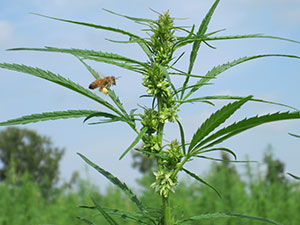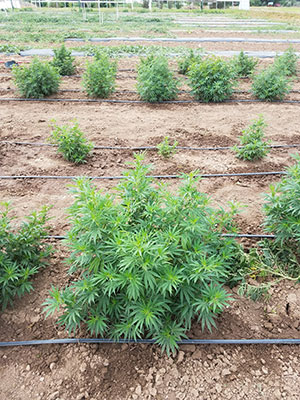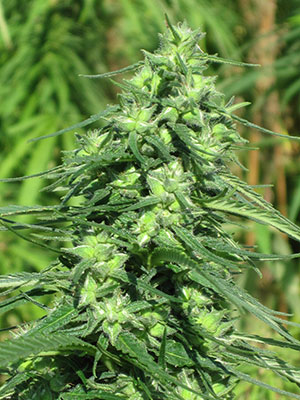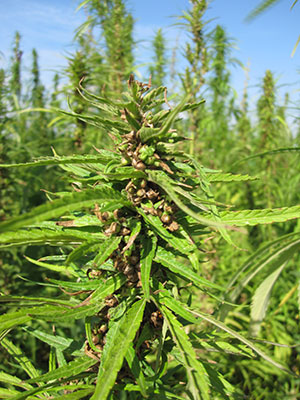by B.A. Mitchell and M.E. Uchanski* (2/20)
Quick Facts…
- Hemp evolved in Central Asia and is one of humanity’s oldest crops, with early cultivation dated around 10,000 years ago.
- Hemp is defined by state and federal laws as plants in the genus Cannabis, plant parts, or derivatives with less than 0.3% THC by dry weight. High CBD cultivars are distinct from those cultivars grown for fiber, seed, and other uses.
- CBD is extracted from unpollinated female hemp flowers which develop special glandular trichomes, the primary source of cannabinoids.
Introduction

Figure 1: A bee approaching a hemp plant to collect pollen for food; note the pollen baskets on the hind legs. Photo: Brian Mitchell
The purpose of this fact sheet is to describe industrial hemp (Cannabis sativa L.) and its production for fiber, seed, and cannabidiol (CBD). The 2014 Agricultural Improvement Act (a.k.a. the Farm Bill), established industrial hemp pilot programs with state governments and at certain universities. Colorado was one of the first states to create a hemp pilot program and Colorado State University (CSU) was one of the first research institutions to begin working with this reintroduced crop, starting with field experiments in 2015 at the Agricultural Experiment Station research centers across the state. Additionally, in 2016, CSU, the state of Colorado, and Pueblo County formed the Institute of Cannabis Research at the CSU Pueblo campus. Many other organizations around the U.S. also leapt into hemp research in the first few years, including Cornell University’s College of Agriculture and Life Sciences, Pennsylvania StateExtension, University of Wisconsin Madison and UW Extension, and the University of Kentucky and Kentucky Department of Agriculture Industrial Hemp Pilot Research Program.
Hemp had been illegal to grow in the United States for nearly fifty years; this prohibition has now effectively ended (Campbell et al., 2019). The Hemp Farming Act, part of the 2018 Farm Bill, removed hemp, previously labeled a Schedule 1 narcotic, from the Controlled Substances Act of 1970. The act also helped to create ways to fund hemp research and ease restrictions on hemp production across the country. States and Tribal Nations are now allowed to submit regulatory plans to the USDA to begin hemp programs (USDA-AMS, 2020). These plans address registration, inspections, testing protocols, and other important aspects of producing hemp. On October 31, 2019, the U.S. Domestic Hemp Production Program released the Interim Final Rule, providing a framework for the 2020 and 2021 growing seasons.
Hemp is defined by state and federal laws as plants of the genus Cannabis, plant parts, or derivatives with less than 0.3% THC by dry weight (CDA, 2019). Hemp can have varying levels of THC based on genetics. The molecule THC has different biochemical forms (e.g., Delta-9 THC, THC-A) therefore, “THC content” can have different meanings, causing some confusion and requiring further clarification. Hemp samples that test well over the legal limit are in violation of federal and state laws and must be destroyed.
Hemp: Then and Now

Figure 2: High-CBD hemp production in an organic field. Photo: Janina Bowen
Hemp is one of humanity’s oldest cultivated crops and evolved on the steppe of Central Asia, today Mongolia and Siberia. Ancient pollen and seed analysis, in addition to written records about growing and using hemp, date hemp cultivation to between 10,000 to 12,000 years ago. Similarly, wheat cultivation began in Turkey around 10,000 years ago and the domestication of maize in Mexico occurred around 9,000 years ago. The first use for hemp was for its fiber in China (Warf, 2014). Seeds found at a Jomon cultural site in Japan date back to 10,000 years ago. Seeds recovered in northern China, home of the Yangshao culture, date back five to seven millennia. Seeds found at these sites also showed signs of domestication, e.g., seed enlargement and the loss of the seed abscission zone, which usually occurs centuries after first cultivation (McPartland and Hegman, 2018). Early hemp cultivators utilized it for three commodities: fibers, seed, and medicinal flowers (McPartland and Hegman, 2018).
Hemp is an herbaceous annual plant reaching heights of 16 feet. Modern industrial hemp is cultivated and processed for fiber, seed, and medicinal compounds, namely CBD. It is in the Cannabaceae plant family, which also includes hops (Humulus lupulus). Hemp grown for CBD production involves asexual propagation (cuttings, transplants, clones) of female plants or the use of “feminized” seed. Production of this gender-skewed seed is achieved through foliar applications of silver thiosulfate (STS) to female plants. A 2018 study by Lubell and Brand showed that most inflorescences (arrangements of flowers) had 100% male flowers when a 3 mM STS solution was applied to female plants; terminal inflorescences had 95% conversion to male flowers. In other words, the application of STS caused female plants to develop male flowers, which will produce genetically female pollen. This reaction was induced consistently and easily in the greenhouse study. The pollination of female flowers using this female pollen will result in “feminized” seed, and produce an all-female plant population, ideal for hemp producers.
High-CBD hemp cultivars (cultivated varieties) are large, bushy plants valued for their un-pollinated female flowers and associated tissues, which hold the highest concentrations of medicinal compounds in the plant (Giroud, 2002) (Fig. 2). Male plants and their pollen are undesirable in a CBD hemp crop as pollinated female flowers are considered lower quality. Hemp grown for fiber, seed, or dual-purpose (seed and lower-quality fiber from the same crop) are quite distinct, both physically and biologically. Some cultivars have male and female flowers on the same plant (monoecious,) and others have separate male and female plants (dioecious) (Figs. 3 & 4). These types of hemp are heavy pollen producers in the summer and serve as an off-season food source (no nectar is produced) for bees and other pollinators (Fig 1).
 Figure 3 (left): A male hemp plant has hundreds of small white flowers and produces copious amounts of pollen! Photo: Brian Mitchell |
 Figure 4 (right):A female hemp plant grown for grain production. Photo: Brian Mitchell |

Figure 5: Maturing seeds on a female hemp plant. Photo: Brian Mitchell
The fiber types of hemp are used to create fabric, rope, insulation, bioplastics, and similar products (Pal and Lucia, 2019). Hemp cultivars bred for fiber production have hollow stems and are less “woody,” allowing the plant’s energy to be directed into those types of cells. Two main types of fibers are found within the plant: the bast and the hurd. Hemp bast fibers are used for textiles, paper, insulation, and construction materials. The bast fibers are long, stringy, and very strong! The hurd fibers of hemp, also known as “shives,” are the “woody,” lignified core tissues of the stem. The hurd fibers are commonly used for animal bedding, pulping, and concrete products (Salentijn et al., 2015). Hemp is also grown for seed and hempseed oil (Fig. 5). Hemp seeds are used in human food products, health supplements, personal hygiene products, lubricants, paints, solvents, and many other products. Hemp seeds contain roughly 30% protein, 25% starch, and 30% oil, with the pressed oil containing up to 90% polyunsaturated fatty acids (Schluttenhofer and Yuan, 2017). There is no measurable THC or CBD present in the seed or hempseed oil (Giroud, 2002).
One of the largest contributors to the recent interest in hemp is the compound cannabidiol, or CBD, a plant-produced molecule that has become a popular health supplement. This type of hemp is similar in appearance and production to marijuana, but with the important legal distinction of having less than 0.3% THC by dry weight (Uchanski and Mitchell, 2019). The flowers and some leaves are covered in special glandular trichomes, the primary source of cannabinoids (Giroud, 2002). CBD, one of numerous known cannabinoids, is reported to have many health benefits. The FDA approved Epidiolex, a revolutionary epilepsy treatment, in 2019. It is the first and only clinically formulated and tested CBD-based drug on the market. Tinctures, lotions, edibles, and numerous other products in the lightly regulated marketplace are also created from CBD extracted from hemp flowers.
Research on the many different uses of hemp has continued in other regions across the world, especially in Canada, Europe, and Asia. There are many open-access research articles about hemp production, focusing on topics such as optimization of hemp fibers for composites, growing hemp in heavy metal-contaminated soils and as a potential tool for phytoremediation, the potential biomass and energy yields of hemp when used for as a biogas and solid fuel, in addition to the numerous studies on fiber quality, harvest times, flowering dates, and other basic production information. Colorado-based research, education, and outreach is needed, including studies about organic production management.
Conclusion
Hemp is an important alternative crop that is reemerging in the U.S. after seven decades of prohibition. Universities, governments, and growers still have much to learn about this crop across the entire supply chain, from farm to consumer. There is also much to be done in improving hemp genetics, securing quality propagation sources (seeds and clones), and optimizing production practices. While the popularity of CBD is driving the current conversation, fiber and seed hemp processing infrastructure will also develop and open new markets for growers.
If you are considering hemp production, it may be best to decide which part of the plant you want to cultivate most (fiber, grain, or flower) and focus on that one end-use and market. Find hemp cultivars that have the marketable characteristics you desire and grow it well. The hemp plant has many different uses, but it may be prudent to focus on just one of them, at least at first. Research at Colorado State University, other land-grant universities, and agricultural institutions around the country will continue to expand. In the next few years, there will be more science-based information on production and processing of hemp for farmers in the United States. The Hemp Resource Center at CSU was developed to begin to address this issue (https://hemp.agsci.colostate.edu/).
Key Websites for Colorado Hemp Growers
CSU Hemp Resource Center: https://hemp.agsci.colostate.edu/
CSU Hemp Insect Website: https://hempinsects.agsci.colostate.edu/
Institute for Cannabis Research: https://www.csupueblo.edu/institute-of-cannabis-research/
CDA Industrial Hemp Program: https://www.colorado.gov/pacific/agplants/industrial-hemp
U.S. Domestic Hemp Production Program: https://www.ams.usda.gov/rules-regulations/hemp
The Interim Final Rule: https://www.federalregister.gov/documents/2019/10/31/2019-23749/establishment-of-a-domestic-hemp-production-program
References
Campbell, B.J., Berrada, A.F., Hudalla, C., Amaducci, S., and McKay, J.K. 2019. Genotype x environment interactions of industrial hemp cultivars highlight diverse responses to environmental factors. Agrosyst. Geosci. Environ. 2:180057 doi:10.2134/age2018.11.0057
Colorado Department of Agriculture – Plants. Industrial Hemp Quick Facts. Retrieved from: https://www.colorado.gov/pacific/agplants/ industrial-hemp-quick-facts .
Giroud, C. 2002. Analysis of cannabinoids in hemp plants. Chimia 56:80-83.
Lubell, J.D. and Brand, M. H. 2018. Foliar sprays of silver thiosulfate produce male flowers on female hemp plants. HortTech 28(6):743-747.
McPartland, J.M. and W. Hegman. 2018. Cannabis utilization and diffusion patterns in prehistoric Europe: a critical analysis of archaeological evidence. Veget. Hist. Archaeobot. 27:627-634.
Pal, L. and Lucia, L. 2019. Renaissance of industrial hemp: a miracle crop for a multitude of products. BioResources 14(2):2460-2464.
Salentijn, E.M.J., Zhang, Q., Amaducci, S., Yang, M., and Trindade, L.M. 2015. New developments in fiber hemp (Cannabis sativa L.) breeding. Ind. Crops Prod. 68:32-14.
Schluttenhofer, C., Yuan., L. 2017. Challenges towards revitalizing hemp: a multifaceted crop. Trends Plant Sci., Nov 2017 22(11):917-929.
Uchanski, M. and Mitchell, B. 2019. Hemp 101. Colorado State University Extension. Retrieved from: https://hemp.agsci.colostate.edu/ .
USDA-AMS. 2020. U.S. Domestic Hemp Production Program. Retrieved from: https://www.ams.usda.gov/rules-regulations/hemp .
Warf, Barney. 2014. High points: An historical geography of Cannabis. Geo. Review 104(4):414-438.
*Brian A. Mitchell, PhD Student & Graduate Research Assistant – Horticulture & Landscape Architecture (HLA); Mark E. Uchanski, PhD, Associate Professor of Horticulture & Extension Specialty Crops Specialist – HLA. 2/20.





